Radxa reached out a while ago asking if I’d be interested in checking out their new RK3588-based Mini-ITX board, the ROCK 5 ITX and of course the answer was yes!
I immediately started devising ideas on how to test and work with the board and I’m excited to show you all what I’ve been doing in some upcoming pieces, though for now, we’re going to stick to the tried and tested performance benchmarks and see how it performs.
Radxa told us that the memory was 10% faster on this board as LPDDR5 was used instead of DDR4 on boards such as the ROCK 5B. Let’s see if that’s true, and if it helps meaningfully!

NOTE: I received the ROCK 5 ITX free of charge for review purposes, however, Radxa have had no say or influence on what I’ve written, all words are my own. There are also Amazon/AliExpress affiliate links in this post where I may receive a small commission if you click and purchase.
Table of Contents
Software Support
Software Issues
Things have moved on a fair bit since my ROCK 5B Review and we have newer kernels available. Praise be! We’re still a way off having mainline Linux on the RK3588-based boards but when it comes to vendor kernels, we have one based on kernel 6.1 at least, so that’s something.
Available Operating Systems
Official Radxa Images
At the time of publishing, Radxa only has Debian 11 images available and these include KDE (K Desktop Environment). I’m hoping we’ll soon see them start to build and offer their full range of Debian and Ubuntu images with CLI and desktop variants.
Armbian
When it comes to Armbian you can either choose to build images for the ROCK 5 ITX using Armbian’s build framework, or download their fully supported images. The former is what I did for the testing you’re about to read (as at the time there were no official images available). You can choose either the 5.10 or 6.1 vendor kernels when building, and I went for 6.1 with the Debian 12 (Bookworm) release. I know this breaks my usual policy of using the exact image the vendor provided but I’ve had enough of that 5.10 kernel, sorry, not sorry. The download page is where you’ll want to go to grab your images, there are even some pre-built application images available these days.
Joshua Riek’s rockchip-ubuntu
The final option of the easily available images is Rockchip Ubuntu from Joshua Riek. It makes a compelling choice if you’re looking to utilise the GPU or want to have a pleasant desktop experience without having to do all of the hacking yourself (though do note Armbian images do now also have similar desktop experiences available).
If you go down the desktop route, you’ll have a fully functioning GNOME desktop environment with Wayland, and 3D hardware acceleration with Panfork drivers. All of this allows you to utilise the hardware on RK3588-based devices so you can even watch YouTube in 4K without stuttering!
Is it a shame that a 3rd party has to do this rather than vendors? Sure, but it’s something at least.

Getting Started
ROOBI OS
I may have had my head in the clouds but ROOBI OS was new to me when I saw the packaging of the 5 ITX, it seems we have an easy-to-use OS installer baked into the eMMC of the board (on retail devices, anyway). Towards the bottom of the linked page above, there is a step-by-step guide you can follow, including Radxa’s own Debian KDE build alongside Armbian desktop/minimal flavours.
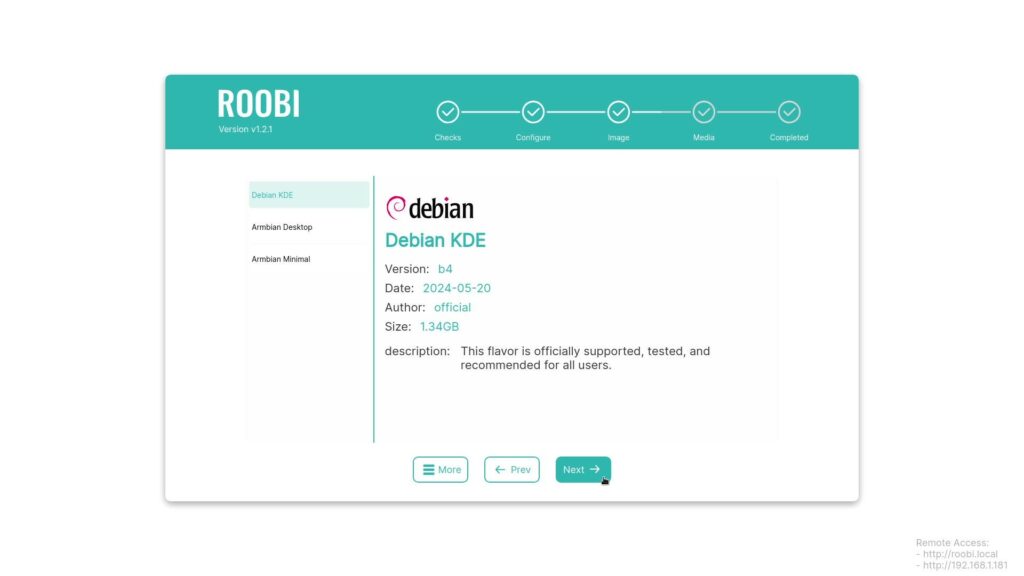
On the box, it states Android, Debian, and fydeOS, though the guide shows a screenshot of OpenWRT, albeit for a different Radxa board. Perhaps with a bit more time, we’ll see those options available within the installer.
As part of the process you can choose the storage device you want to install to and I can confirm that microSD, NVMe, and SATA are all supported.
The Old-Fashioned Way
If you don’t want to touch ROOBI OS you have the good old-fashioned “flash to your chosen boot media” option, with any of the options we covered above. So far I’ve been able to boot from eMMC, NVMe, and microSD, though again, the eMMC on production models will only be 8GB and used for ROOBI OS.
Specifications
| Radxa ROCK 5 ITX | Radxa ROCK 5B | |
|---|---|---|
| Processor | Rockchip RK3588: big.LITTLE Quad-core ARM Cortex-A76 @ 2.4 GHz, Quad-core ARM Cortex-A55 @ 1.8 GHz | Rockchip RK3588: big.LITTLE Quad-core ARM Cortex-A76 @ 2.4 GHz, Quad-core ARM Cortex-A55 @ 1.8 GHz |
| RAM | 8GB LPDDR5 (with 4GB, 16GB and 32GB options) | 8GB LPDDR 4x (with 4GB and 16GB options) |
| Wireless Connectivity | None by default, WiFi 6E and BTE 5.2 M.2 add-on card available to purchase | None by default, WiFi 6E and BTE 5.2 M.2 add-on card available to purchase |
| Ethernet | 2 2.5 Gbit Ethernet (with PoE support with optional PoE module) | 2.5Gbit Ethernet RJ45 port (with PoE support with optional PoE hat) |
| USB Ports | 4 USB 3.0 Type-A ports, 2 USB 2.0 Type-A ports, 1 USB 3.0 Type-C port (with altDP mode), 2 USB 2.0 via Front USB Header | 2x USB 3.0 Type-A ports, 1x USB 3.0 Type-C port, 2x USB 2.0 ports |
| GPIO Headers | None | 40-pin GPIO header |
| Display Output | 2 HDMI® ports (1 4Kp60, and 1 8Kp60 supported), 1, 1x USB-C via DisplayPort alt. mode up to 4Kp30, 2 MIPI DSI connectors | 2x HDMI® 2.1 up to 8Kp60, 1x USB-C via DisplayPort alt. mode up to 8Kp30 |
| Camera Ports | 2 MIPI CSI camera ports | 2 MIPI CSI camera ports |
| Video Input | 1 HDMI input up to 4Kp60 | 1x micro HDMI input up to 4Kp60 |
| Graphics | Mali G610MC4 GPU, 6TOPS NPU, 8K 10-bit encoder, 8K decoder | Mali G610MC4 GPU, 6TOPS NPU, 8K 10-bit encoder, 8K decoder |
| Storage | M.2 2280 socket for NVMe SSD (PCIe 3.0 x2), MicroSD card socket, eMMC flash socket, 4 SATA connectors | M.2 2280 socket for NVMe SSD (PCIe 3.0 x4), MicroSD card socket, eMMC flash socket |
| Power Input | 12V DC via Barrel Jack (5.5×2.5mm) 12V DC via 24-pin ATX Power Connection Power over Ethernet (PoE) enabled (with module) | USB Power Delivery via USB-C connector 5V DC via GPIO header Power over Ethernet (PoE) enabled (with hat) |
| Dimensions | 170 x 170 mm (Mini-ITX form factor) | 100 x 72mm (Pico-ITX form factor) |
Testing Details
I won’t be comparing the ROCK 5 ITX against the ROCK 5B mentioned above in every test as it feels a little pointless as they’re boards in different form factors and I believe they’ll be used in different situations. Not everyone will be looking for a Mini ITX setup, however, so where I feel it’s interesting (in RAM-heavy tests for example) I’ll mention it, but for others, we’re just seeing how the 5 ITX fares.
To give you the usual quick pre-benchmark disclaimer, the performance governors were used during all tests, I had a full LGA115x CPU cooler on the board to prevent any thermal throttling (except during temperature testing, naturally), and all tests were run 3 times so the numbers you see are the averages of that. If I missed anything, berate me in the comments.
As for the OS, we’re using Armbian 24.5 based on Debian 12 (Bookworm) with the vendor-provided Linux kernel 6.1.43. Finally, for all benchmarking, I’m using a PicoPSU in the 24-pin ATX power connector with its own SATA power connection split out into 4 with an adapter rather than using the onboard floppy to SATA converters.
ROCK 5 ITX: Compute Benchmarks
I’m not expecting there to be a massive amount of variance between these and other RK3588 boards that I’ve tested before (like the ROCK 5B or Orange Pi 5 Plus) however as mentioned before, we’re rocking DDR5 memory here, so does a faster clock speed make for bigger numbers across the board?
Now, as a pre-warning, a lot of these benchmarks (the CPU ones in particular, such as Geekbench/UnixBench) aren’t truly testing the hardware itself. They’re heavily influenced by the software being used, and that’s why these numbers should be taken with a pinch of salt if you choose to compare them to numbers from your tests. This is meant to be an overall test of the image and system rather than telling you “This is exactly what the RK3588 is capable of”.
Geekbench 6
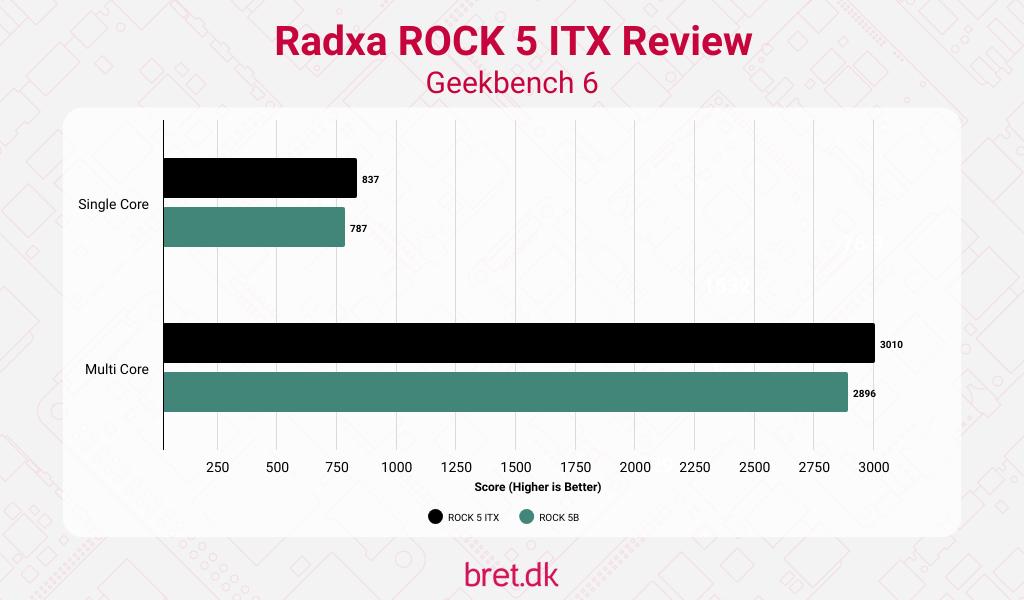
UnixBench
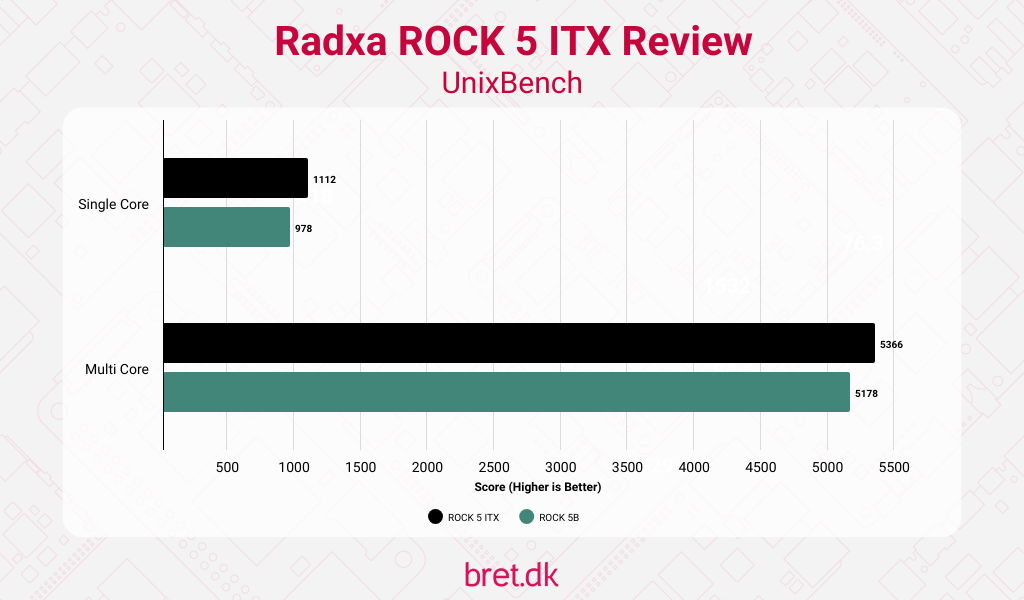
PassMark PerformanceTest
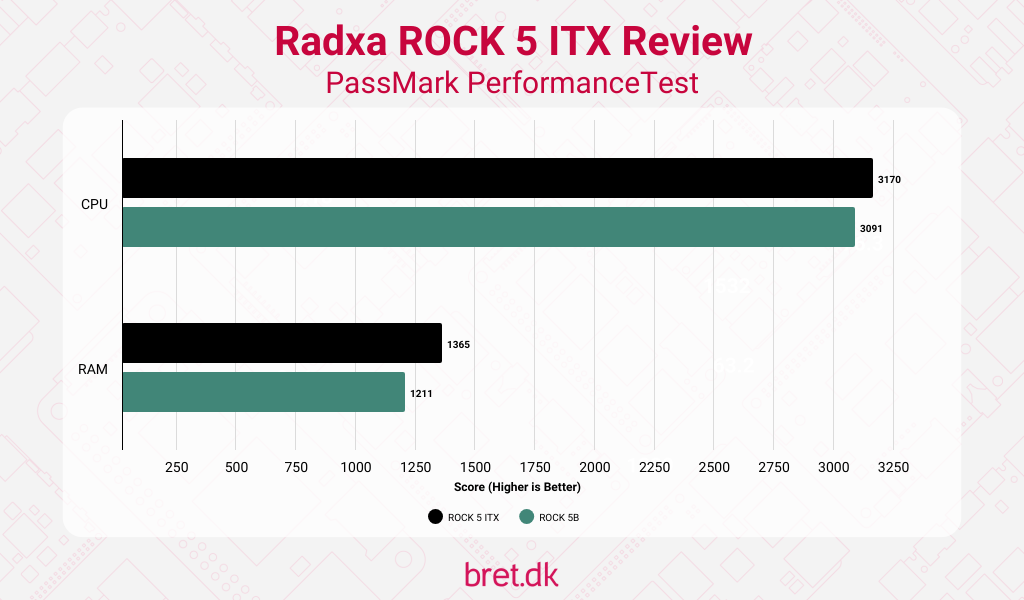
cpuminer-multi

Network Benchmarks
Ethernet
Dual 2.5GbE RJ45 Ethernet on the 5 ITX makes it a rather nice option for modest network-attached storage (NAS) setups. It has no problem saturating this on both ports simultaneously in either direction.
Storage Benchmarks
NVMe SSD
One interesting thing to note about NVMe is that compared to the ROCK 5B’s 4 PCIe Gen 3 lanes, the 5 ITX only has 2. This is because the other 2 were given to the SATA controller that we’ll check out next.
SATA SSD
Testing SATA storage on an ARM is a first for me (I never got around to owning some of the older ODROID devices that supported this, apologies), and we have 4 SATA connectors (with accompanying 4-pin floppy power connectors) available to us, making this a potentially fun NAS project (not foreshadowing at all).
To test this I have 4 Samsung 870 EVO SATA SSDs in RAID 0 to push the controller/board, and I’ll test a single drive to see how that goes.
eMMC
There’s a bit of a caveat here, as the early model I received for review comes with 32GB of eMMC storage but the production models will have just 8GB and will be pre-loaded with the ROOBI OS I touched on earlier. Perhaps you can wipe that and use it for a minimal OS? Either way, I tested the eMMC just in case.
microSD Card
Annoyingly, the 4th (well, 3rd technically given the above) storage option is one of the best microSD card results I’ve had in any of my benchmarks on an ARM-based system. With SDR104 / UHS-I on offer, it shows, and with the Amazon Basics 64GB microSD card, the results speak for themselves. I only say annoyingly as this is the board that most of us are likely to choose alternatives for but it’s good to know that it’s there if needed.
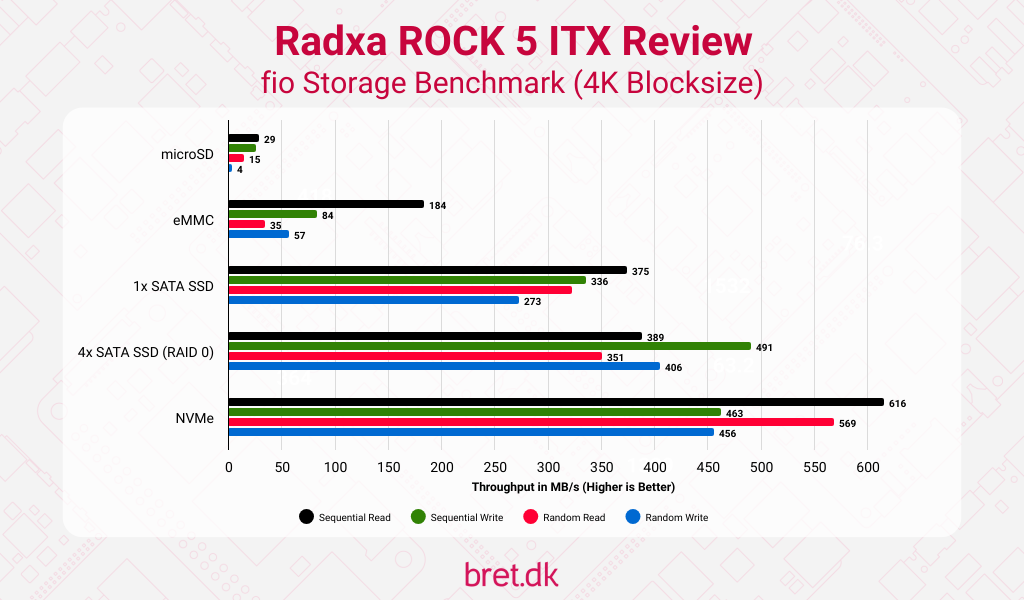
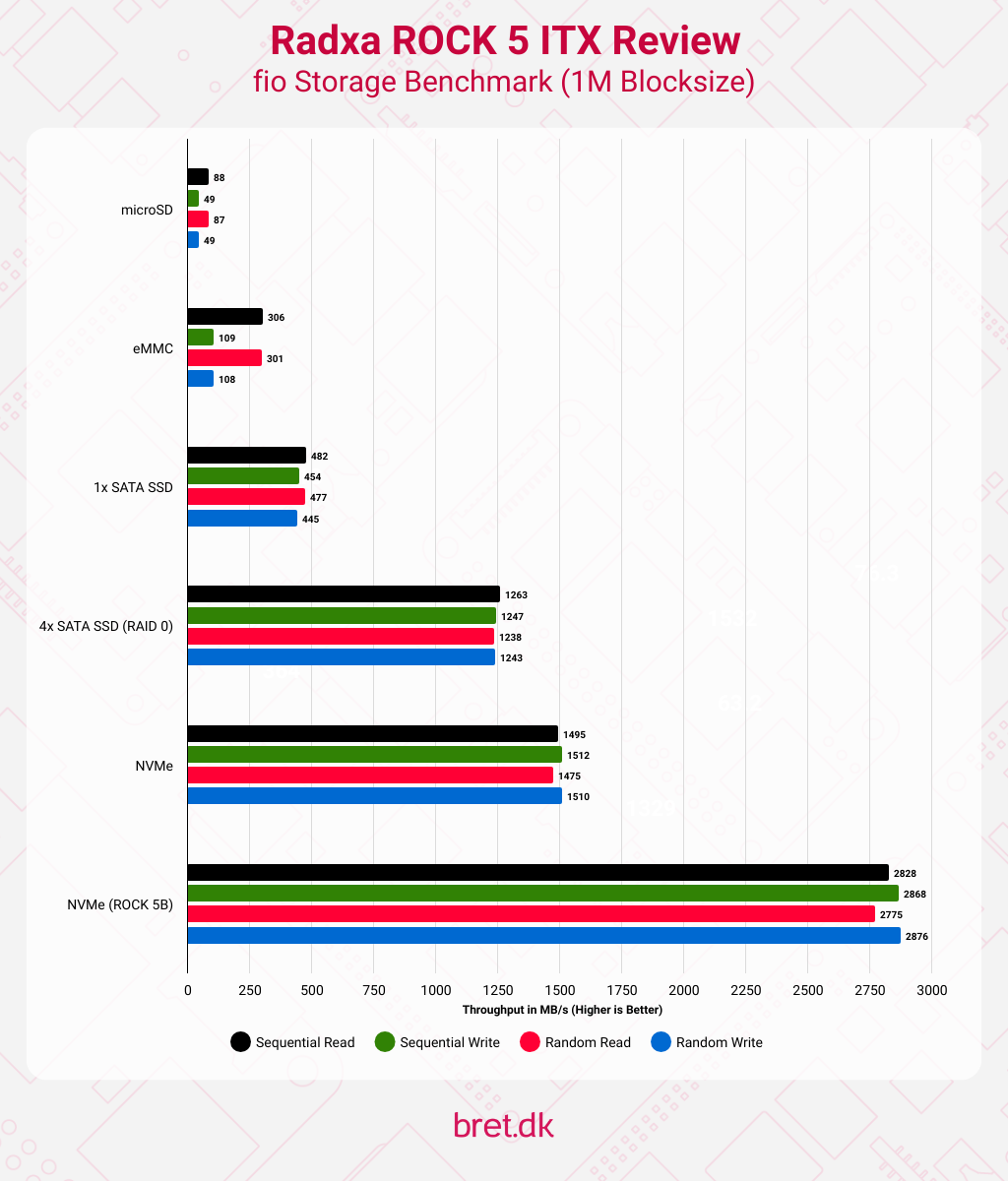
Temperatures
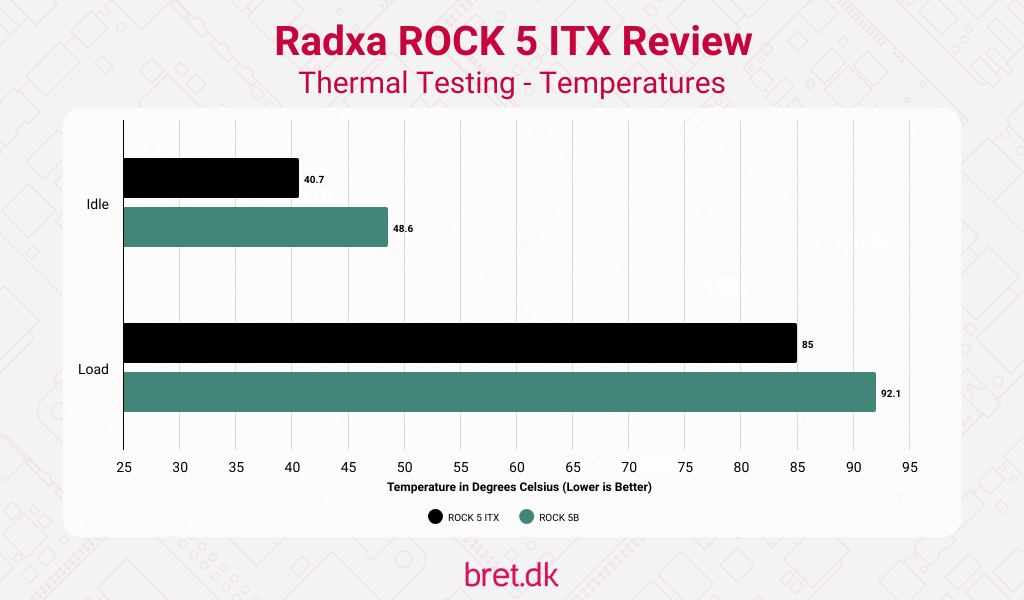
Power Consumption
There’s a lot more going on on the ROCK 5 ITX so power consumption is naturally going to be a little higher than a small SBC for example, but given that this is meant to be a low-power desktop option, these numbers are quite good.
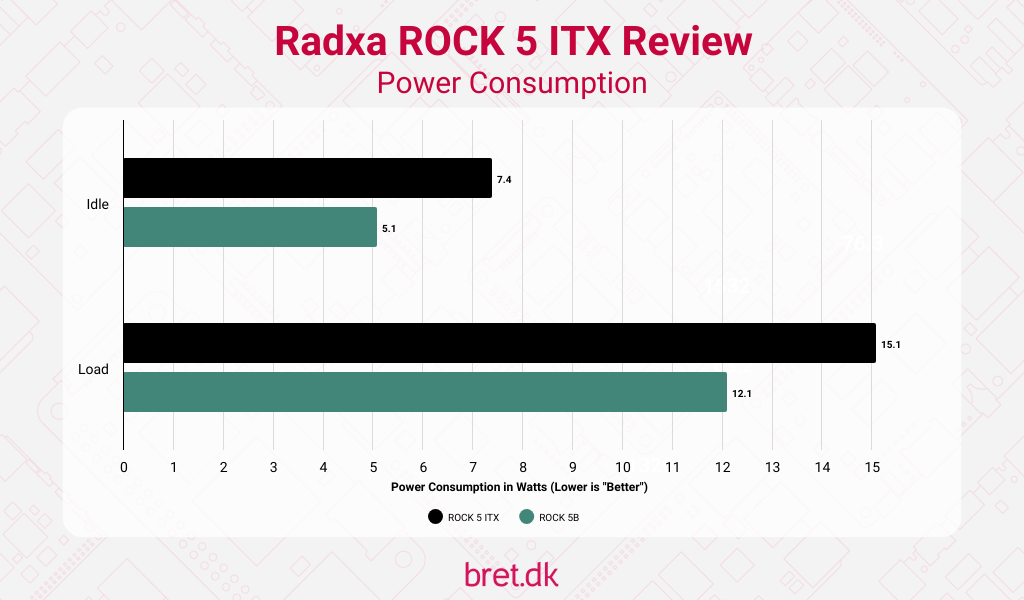
Thoughts & Notes from Testing
OS Installations
Having Roobi OS available to perform quick OS installs was a pleasant change. As long as the repositories pointing at the images is kept up to date, this is a nice way to shave off some time when getting up and running.
microSD Card Performance
Whilst it’s not going to be at the top of most of your lists of reasons to buy, it was nice to see? With a good quality card, this could be a nice option for booting certain operating systems from, or for having as some additional storage.
Power over Ethernet
PoE is available on both 2.5GbE ports on the 5 ITX and I think that’s awesome. I have the PoE module here and in a high-quality PoE switch (I use the Ubiquiti UniFi 16 PoE Lite) you’re going to have no problems unless you go crazy with disks and peripherals.. Some SATA SSDs in a NAS setup with power and networking over a single cable? Yes, please!
Temperatures (Good and Bad)
I think the large footprint of the PCB is helping a little here, though overall, the temperatures on the ROCK 5 ITX are pretty good. Though they claim you can mount LGA115X CPU coolers to the board, the mounting holes are too small for a lot of coolers (including the stock Intel cooler) and it took me 2 returns to Amazon before finding one that actually fit. That was a super cheap Xilence unit which is still over the top, so do beware that not all LGA 115X coolers will fit here.
Where can I buy a Radxa ROCK 5 ITX?
There are a handful of places to buy a ROCK 5 ITX at the moment, though interestingly Radxa just opened their own AliExpress store which is nice for those of us in countries where tax can be collected at payment, avoiding the customs/import tax dance with our local carriers.
Pricing was initially mentioned by Radxa as follows:
- 4GB LPDDR5: $99
- 8GB LPDDR5: $119
- 16GB LPDDR5: $159
- 32GB LPDDR5: $239
The stock of the different models seems to be rather up and down at the moment, so with Arace, Amazon, AliExpress, and ALLNET (why do they all begin with A?) being global suppliers, you can check through each of them to see if they have what you need. If you’re in mainland China, Taobao has you covered, with Hubtronics available for Indian readers.
Conclusion
I like it. Having the RK3588 in an ITX form factor is rather nice, and the I/O available on the board means that it will serve quite a few different use cases. I’ve hinted to it a few times through the piece but I’ll be looking to see how my SATA SSD setup fares when set up as a NAS (Network Attached Storage) machine and see what we can get out of the drives over the network on various protocols.
If you manage to pick one up at the recommended prices then I think the 8/16GB is the sweet spot and worth the money.
Finally, with Collabora still putting in considerable effort to get the RockChip RK3588 ready for mainline action, this, and so many other boards will become considerably more useful soon (hopefully). Sure, we have slightly newer kernels these days from the vendor but it still feels a bit dirty, even if the experience is really quite good.
—–
Also, as a note, this review was initially written back in June and then re-written slightly on publishing now in September. If you spot anything weird, please let me know!






3 comments
Beware that when you power it off, the PSU is still on. In my case it uses 8W in power off mode with 200W flexATX PSU.
The idle power consumption numbers you presented – were they measured in a desktop environment with HDMI and USB connected? If this was the case, can we expect an Idle power consumption of about 4-5 watt when used as a headless server?
Thanks.
Hi, in my case it was headless sever.
8W power off
17-20W ide
3x 3,5″ HDD, 1 Sata SSD, 1 NVME
Hard to say what efficiency ITX AK-I1-200 have.